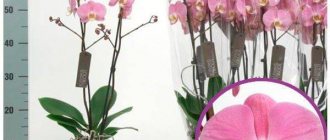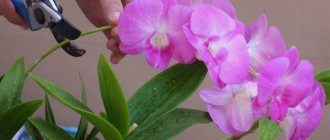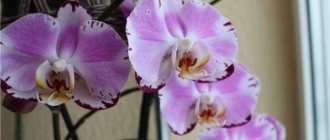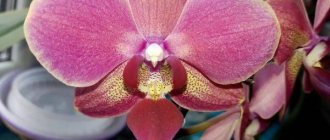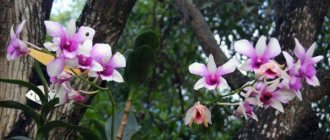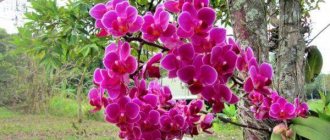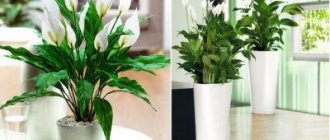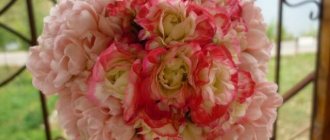Any variety of orchid loves to be carefully and attentively cared for. The owner of this plant must create all the conditions :
- Required humidity;
- Proper watering;
- A certain amount of sunlight.
And only in this case can you get rich flowering of the orchid. at how to properly care for these varieties of phalaenopsis: Mandala, Manhattan, Maria Teresa, Mayang Angel in our article.
Description of Phalaenopsis
Mandala
This type of Phalaenopsis has a pleasant creamy hue , the length can reach up to 50-60 cm in height. During flowering, the flower size is about 6-9 cm. See photo of Phalaenopsis Mandala below.
Phalaenopsis Mandala has a fabulous color.
The distinctive feature of the Mandala Orchid is its appearance: a beautiful creamy-golden flower with a white center and a small tiger-colored lip.
The plant, like other types of Phalaenopsis, requires high humidity , moderate watering and protection from exposure to sunlight.
For propagation, they use the “baby”, which the orchid throws out after flowering .
Active growth and flowering is observed during winter and spring , at this time it is recommended to fertilize with special fertilizers.
The optimal air temperature is considered to be from 18 to 25 0 C. During the flowering period, the plant must be watered as the soil dries.
And in this video you can look at the Mandala (rewind to 3 minutes 30 seconds):
Manhattan
We recently published a separate article about this variety. The Manhattan variety is a hybrid orchid , a very beautiful and delicate plant. It was bred by breeders back in the late 60s of the twentieth century by crossing several species of orchids. You can see Phalaenopsis Manhattan in the photo below.
All Phalaenopsis Manhattan flowers are covered with purple dots.
This was done in order to obtain a unique flower and optimal conditions for growth. Scientists have achieved success by obtaining a special variety of this variety, Manhattan butterfly.
It really looks like small butterfly wings with a bright center. In principle, this orchid is not very whimsical and will not cause discomfort in care.
Unlike other varieties, Manhattan does not require precise adherence to certain temperatures and air humidity.
Watering should only be done when the soil is completely dry . In summer, this procedure is recommended to be carried out 1-2 times a week, in winter - once every two weeks.
It is better to place the plant in a place where it will receive sunlight . The optimal temperature for growth is considered to be normal room temperature.
The process of transplantation and propagation is recommended to be carried out after all the flowers have faded.
A characteristic feature of Manhattan orchids is their color : from soft lilac to rich purple.
The Manhattan orchid has large flowers.
Each flower is covered with a huge number of small dots , the lip has a bright orange tint.
a height of 60 cm, the size of flowers on average is up to 10 cm.
Watch the video to see what the Manhattan orchid looks like:
Maria Teresa
One of the brightest orchids, has an orange-coral color, the plant reaches 50-60 cm in height, the size of the flowers is about 8-9 cm.
Like other Phalaenopsis varieties, the birthplace of Maria Theresa :
Appearance of the variety Maria Teresa.
Outwardly, like all orchids, it resembles a butterfly with rounded petals. It blooms, as a rule, 2 times a year, lasting 2 months.
The rest period is several months . Does not require special conditions for care. Phalaenopsis Maria Teresa can be seen on the right in the photo.
It is enough to comply with the following conditions :
- Proper watering and feeding;
- Temperature and humidity should be at room temperature.
water the orchid as the soil dries out. Reproduction is carried out by transplanting the “baby”, which the orchid throws out 1-2 times a year with proper care.
During the dormant period, it is not recommended to change the location or feed the plant. The lifespan of this orchid variety is 10-15 years.
Some of the species of this plant can please their owner with rich blooms , which will resemble a bouquet of orchids.
Find out in the video how to get the Phalaenopsis Maria Teresa to bloom:
Mayang Angel
The multi-flowered phalaenopsis Mayang Angel is distinguished by its unique appearance . Large white flowers have dots and streaks of bright purple, the middle of the flower is orange with lilac splashes.
The Mayang Angel orchid is a hybrid variety of Phalaenopsis. Thanks to selection, the resulting plant is quite unpretentious and does not require special care compared to other varieties of orchids.
Variety Mayang Angel.
The optimal temperature for keeping is considered to be 18-23 degrees, humidity up to 70-80%. In the early morning and evening, direct sunlight is allowed on the plant.
Reproduction is carried out in the traditional way for all orchids. The stem of the peduncle is tall and thin; it can accommodate up to 7 flowers measuring 7-9 cm.
Flowering occurs over several months with short periods of dormancy. Fertilizing is best done during the period of vegetative growth .
It is important to observe the correct watering conditions:
- In winter, once every 2 weeks;
- In summer -1-2 times a week.
It is necessary to ensure that the soil dries out; you can spray the plant to create additional moisture.
Jewel
Distinctive features, external characteristics
Phalaenopsis Jewel or its other name, Emperor's Pearl, is a monopoidal epiphyte.
The plant grows quite large:
- The stem is short, bears 4-6 double-rowed fleshy, elongated elliptical leaves, dark green in color.
- The leaves reach 15-35 centimeters in length, 5-10 in width.
One of the large-flowered hybrids : flowers are 6-8 centimeters in diameter, standard shape.
Amazing color of the Jewel orchid.
The peduncle is inclined, about 70 centimeters long. The inflorescence is racemose, branched, multi-flowered.
Flowering in November-February.
Story
Phal hybrid. Dolores and phal. RosyPam (1961).
Colors
The flowers are dark crimson, deep carmine in color with gradations to white at the edges of the petals. The structure of the flower is delicate. You can be convinced by looking at the photo of the Jewel orchid below.
Emperor jewel
Features and duration of flowering
Artificial temperature changes will increase photosynthesis and, accordingly, plant development. Flowering lasts 3-4 months . It does not have a pronounced rest period.
Conditional dormancy can be called a period when the plant does not bloom, but actively grows foliage and roots.
Varieties with the word Jewel in the name
- Phal. Red Jewel,
Multiflora Red Jewel.
- Phal. Lemon Jewel,
- Phal. Garnet,
Phal Zuma Garnet 'Plantation'.
- Phal. Jewel Lips,
- Phal. Ruby Jewel.
Phalaenopsis Penang Ruby Jewel.
And in this video you can see the Emperor Jewel variety live:
Main features of proper landing
Soil selection
To plant these plants, use a standard orchid substrate , which includes oak bark, a small amount of peat and drainage (such as coco chips or polystyrene foam).
You can buy ready-made at a flower shop or prepare it yourself. In the latter case, the proportions must be observed correctly.
Pot
As a rule, these orchids need to be planted in a plastic container , at the bottom of which there are holes for water access.
This container can be placed in a glass or plastic pot of any color.
The plant must be replanted into a pot that is 2 cm larger than the previous one .
Technology
To do this you need :
- Place drainage at the bottom of the pot;
- Then pour in a small amount of substrate;
- Place the plant there and sprinkle with the rest of the soil.
Under no circumstances should you put pressure on the orchid , this can lead to damage to the root system. It is recommended to replant once every 2-3 years or as the plant grows.
The nuances of transplantation
Transplantation of these varieties of Phalaenopsos must be done when the plant has finished flowering , but has not yet entered the dormant period. It is best to do this in the autumn.
Description
P kaode twinkie belongs to plants that lead an epiphytic lifestyle. Taking a closer look at the flowering hybrid, you will notice that its color is not black, as it seems at first glance. The color is achieved due to the rich purple-burgundy color of the petals. The rich purple hue of the hybrid and the white-yellow lip create an optical illusion. The effect is enhanced by the light tepal, which contrasts strongly with the dark petals.
The plant has a light, unobtrusive aroma, which is strong in the morning or evening. The aroma of the hybrid increases with increased humidity around the trunk. At the beginning of development, each subsequent phalaenopsis leaf is larger than the previous one. The foliage becomes uniform in size after the crop reaches two years.
Home care rules
Conditions of detention
conditions are considered optimal:
- Temperature within 18-25 degrees;
- Air humidity up to 80%;
- Moderate lighting, sunlight allowed in the morning and evening.
Watering and fertilizing
It is necessary to water the orchid as the soil dries out , usually once a week in the summer and once every 2 weeks in the winter.
Fertilizing must be carried out during the period of vegetative growth of the orchid; special mineral fertilizers are used.
Disease Prevention
If orchids have been exposed to fungal growth, this is due to overwatering the plant. Therefore, first of all, you need to water the orchid moderately .
To prevent fungal diseases, use special fungicides and treat the plant once every 10-14 days.
To prevent burns on orchid leaves, you need to carefully monitor the amount of lighting ; do not place the pot in direct sunlight.
To prevent the leaves from freezing, be sure to control the temperature level in the room where the plant is located.
Pests
Inspect the leaves for pests every time you water. Immediately after purchase, place the phalaenopsis pot in a container of water. This will clean the flower from possible pests. A variety of centipedes, spiders, cockroaches, woodlice and earthworms usually live in the substrate. The plant itself can be affected by aphids and mites.
Remove all scales, old leaves, and dried pseudobulbs in a timely manner. Treat the plant with soapy water, remove insects manually, Fitoverm helps a lot, treat the plant with it according to the instructions. During prevention, it is advisable to wash and wipe the leaves dry, and rinse the substrate under running water.
Phalaenopsis Black pearl (black pearl). The first flowering of a teenagerRobert van Gulik. Emperor's Pearl 1BRIEF REVIEW OF FLOWERING ORCHIDS. What's blooming right now MARCH 01, 2018
Phalaenopsis Luddeman
Phalaenopsis lueddemanniana is the scientific name of a species of orchid of the Phalaenopsis family, first introduced into floriculture in 1864. The first horticultural farm to cultivate this variety was Lowe and Co. Its owner, E. Clipton, mistakenly mistook the plant for Phalaenopsis Equestrian, scientifically known as Phalaenopsis equestris.
The first flowering of this species during its cultivation was achieved by a breeder from Paris - F. Luddeman. The orchid owes its name to him. A year passed from the moment the variety was introduced into cultivation until the flowers were obtained; flowering was noticed in 1865.
Description of the plant
Phalaenopsis Luddeman is similar to many species of orchids of the Phalaenopsis family - the shape and size of the leaves, the presence of aerial roots. The most clear difference is manifested in the appearance of the flowers.
Root system
Orchid belongs to plants of the genus epiphytes. In addition to ordinary roots, it has aerial shoots . With their help, the plant is fixed on tree trunks and other supports. Another function of aerial roots is to participate in the process of photosynthesis - converting sunlight into nutrients.
The peculiarities of life activity determine the presence of a developed root system with long and branching shoots in this flower.
Healthy roots are elastic and smooth. If they have access to light, they have a rich green color due to the chlorophyll content in the shoots. Otherwise they do not have a bright color.
Stem and leaves
This orchid is a medium-sized species; it is often classified as a miniature variety - the shortened stem of the orchid is completely hidden by the leaves. Their number can reach 6-8 pieces. The leaves grow in pairs on the stem. The length of the leaves varies from 10 to 25 cm, the width reaches 5-10 cm. The appearance of the leaves is characterized by the following features:
- Elongated oval shape;
- Blunt at the ends;
- The color is light green, yellow-green or light green;
- Thickened, tough, succulent.
For reference! Succulent epiphytic orchids are plants whose leaves have special moisture-storing cells. They are able to retain moisture and use it when the importance of feeding by aerial roots decreases. This situation can occur if there is insufficient moisture content in the air.
Peduncle, inflorescences and flowering
The orchid peduncle sprouts from the base of the stem and reaches a length of up to 35 cm. At the same time, from 2 to 7 medium-sized flowers are formed on it - from 4.5 to 6 cm. The inflorescences of the plant are characterized by the following properties:
- Wax petals;
- The color is white with horizontal purple or reddish-brown stripes, there may be yellowish inclusions;
- The color of the orchid's lip (the lower petal of the perianth located in the center) is different - it is white, with a hint of purple. A distinctive feature of the species are clearly visible, yellow markings on the lip;
- The flowers have a distinct pleasant aroma.
The shape of the petals, the number of transverse lines, and their intensity may vary from plant to plant.
The buds bloom over a long period of time, gradually one after another. Each of them continues to flower for 25 - 30 days. The orchid can bloom year-round, but peak flowering occurs from spring to September .
Intrigue
Distinctive features, external characteristics
Phalaenopsis Intriga is a monopoidal epiphyte with a rather rare flower color:
- Medium sized plant;
- The leaves are paired, up to 30 centimeters in length, dark green;
- Peduncles appear at the base of the stem. The peduncle often branches, forming secondary shoots, which increases the number of flowers;
- The flowers are standard in shape, dense, 6 centimeters in diameter .
Story
Dutch, beautifully flowering hybrid.
Colors
The color is predominantly pink:
- The petals and upper sepals are deep pink, the outline is dark pink, the border has a complex, ragged shape;
- The lower sepals are light pink or white with dark pink, small inclusions, deep pink contours, complex shape transition;
- The lip is purple with a yellow center.
Phalaenopsis Intriga has a rather rare flower color.
Features and duration of flowering
It blooms from November to April , the lifespan of an individual flower is 20-40 days. Due to the fact that the plant can “grow” shoots on the peduncle, this variety can bloom throughout the year.
It has no obvious rest period.
You can look at the Intriga variety in this video:
Conditions of detention
Successful cultivation of lumpfish depends on compliance with the requirements for its maintenance. Temperature and humidity indicators, degree of lighting, and regularity of watering are determined by the natural growing conditions of orchids. They are optimal for maintaining the normal functioning of the plant and obtaining abundant flowering from it.
The homeland of this species is the Philippines, a country with a humid and hot climate. At home, these indicators should also be at a high level.
Temperature and lighting
Phalaenopsis Luddeman belongs to the warm temperature group. In the room where the flower is cultivated, in summer the temperature should be set to 31-34°C during the day and 23-24°C at night. In winter, the temperature drops to 30-33°C during the daytime and to 21-22°C at night.
The temperature difference between day and night temperatures of 7-10°C is taken into account. It is necessary because it prevents the plant from becoming exhausted at night when it uses up the energy accumulated during the day. Too sharp a drop has a negative impact on the condition of the flower - it begins to shed its leaves.
In its natural environment, the orchid grows on the branches and trunks of trees, between the crowns, protecting it from the hot rays of the sun. Therefore, at home it should be grown in shade or partial shade. It is better to place a flower pot on the windowsill of eastern or western windows, and shade it with tulle on sunny days. Orchids can also be grown under completely artificial lighting - using fluorescent lamps.
Important! Daylight hours should be at least 10 and no more than 14 hours. With a lack of light, plant growth slows down. An excess of light is also undesirable - the leaves will begin to turn yellow and fall off.
Special attention should be paid to lighting the orchid roots. In this species, they participate in the process of photosynthesis, so a suitable container for it is a transparent pot or basket. It will provide the root with access to light. It is possible to plant an orchid on a block.
Humidity
In the natural environment where the Luddeman's orchid grows, air humidity ranges from 60 to 93%. Moisture levels in the air drop during the winter months, from December to February. A weakly expressed period of rest is associated with this same period.
When growing orchids at home, the average humidity level is about 65-80%. In order for the plant to bloom, increase green mass and produce new shoots, humidity and temperature should be maintained at a high level, but within normal limits.
Watering
Watering a given orchid depends on the stage that the flower goes through at a certain time. During the active growing season - during the formation of buds, new roots, aerial shoots and foliage - abundant watering is required. The substrate is constantly kept slightly moist. Moistening is carried out when the soil is slightly dry, but not completely dry.
Note! Do not over-moisten the soil. A substrate that is too wet is a favorable atmosphere for the development of infectious diseases and fungi, including those that cause rotting.
During the mild dormant period that occurs in winter, watering is significantly reduced. This is due to a decrease in relative air humidity and ambient temperature.
In addition to the usual watering at the root, it is possible to spray the top layer of the substrate. In this case, it is important to prevent moisture from entering the rosette and leaf axils. If this happens, remove the water from there using paper napkins by blotting the wet areas.
For irrigation, it is recommended to choose purified soft water. Melt or rain water can be used. Hard water contains impurities that destroy the substrate and make it difficult for the roots to absorb water.
Orchid blossom
The standard will delight you regularly with its beautiful flowering. To do this, you just need to follow some rules. Try to water the plant according to a certain schedule, and in no case allow it to be exposed to direct rays. In autumn and winter, try to “increase” daylight hours as much as possible with the help of lamps.
As soon as the plant is able to send out one or more arrows at the very beginning of spring, after a certain time beautiful flowers will quickly begin to bloom on it, and with a beautiful rich color. If we talk about the flowering period, it can also last up to five months, everything depends solely on the presence of certain external factors, as well as the microclimate that will surround the trunk. When the last flower falls off, try not to rush to cut off the arrow itself. The fact is that over time, new branches, supplemented by buds, will begin to grow from it.
What to do if it doesn’t bloom
This plant loves warm temperatures. The optimum temperature for flowering and growth in normal summer is 30 degrees, and in winter - 20 degrees.
Orchid care
For abundant flowering and growth of an orchid, not only the basic needs of the flower should be satisfied. The orchid needs additional care - feeding .
Fertilizer
Feeding an orchid is carried out through watering, that is, during every second watering the plant is fertilized.
The following fertilizers are used as top dressing:
- Mineral - special formulations purchased in the store. You should choose those that are intended for orchids. This will allow for balanced feeding without excess microelements that the orchid is not able to absorb.
- Organic - rotted horse manure. When using organic fertilizers, it is important not to oversaturate the soil with nitrogen. Otherwise, the substrate quickly becomes unusable - the soil becomes acidic and its breathability deteriorates. For orchids, such growing conditions are destructive.
In winter, when the flower is dormant, fertilizing is excluded from normal care. They resume with the transition of the orchid to the vegetative stage - in the spring. At this time, phalaenopsis is fertilized once every one to two weeks. During the growing season, only mineral fertilizers intended for orchids are used. The concentration of their dose is reduced by 2, 3 or 4 times from the dose recommended on the package.
Bloom
Phal kaoda twinkle will constantly delight its owners with its flowering, provided simple rules are followed:
- maintaining proper watering;
- installing the plant in a place where the sun's rays will not reach;
- increasing daylight hours in the autumn-winter period using fluorescent or phyto lamps;
- moderate feeding.
After following the necessary agricultural practices, the orchid will produce from one to five peduncles in early spring, on which, after two to three weeks, flowers of a rich dark shade will gradually begin to bloom. Flowering time can last from 2.5 to 9 months and will depend on the microclimate surrounding the plant.
Important! After the last petal falls on the flowers, you should not trim the peduncle. By increasing the humidity, you can achieve the development of new branches with buds on the arrow.
Reproduction
One of the features of this epiphyte is the frequent appearance of “babies” in large numbers. The orchid forms them on the old peduncle after flowering, if favorable conditions have been prepared. To do this, maintain humidity at 70-80% and temperature at least 28-30°C.
“Children” are formed on plants that are at least 2 years old and have at least 4 leaves. They can germinate on faded peduncles if they are not older than one and a half years.
Caring for the “babies” after their formation for orchid propagation is as follows:
- You should help the mother plant by spraying the roots of the “babies” with a spray bottle.
Advice! The roots of each “baby” can be wrapped in sphagnum moss. This will help retain moisture in them for a longer period.
- After the “babies” have formed roots 4-5 cm long and 3-4 leaves, they are disconnected from the mother plant along with part of the peduncle. The cut areas are treated with crushed coal, potassium permanganate or brilliant green.
Important! You shouldn't wait for the roots to grow longer. This will complicate the transplanting process, since the fragile long roots can be easily damaged.
- The separated “babies” are planted in small containers with a diameter of 6 to 9 cm, depending on the size of the new orchid.
After transplantation, separated orchids are often sprayed so that they quickly become accustomed to independent life.
Care instructions
Read the detailed instructions for caring for this plant; it will make your life much easier. Phalaenopsis Kaoda loves good conditions.
Selecting a location
It is advisable to place the plant exclusively on the windowsill itself, located on the east or west side. Try to avoid direct rays, this is very dangerous for your orchid. Lighting should in no case deprive this flower of warm and soft shades. Kaoda will simply fade in insufficient and unfavorable lighting.
Preparing the soil and pot
If we talk about a pot, then you should definitely grow the plant not just in pots, but in wooden baskets. The diameter of a regular pot is usually up to 10 centimeters. You can put regular moss on the surface of the soil. This is ordinary sphagnum for drying out roots. Moss mainly serves as a regular indicator for watering. As soon as it dries completely, after a few days the plant should definitely be watered.
Temperature and lighting
The Kaoda plant loves not only warmth, but also rather soft lighting, preferably a moderate temperature regime. The optimal temperature is considered to be about 30 degrees. In winter, the temperature may be slightly lower.
Humidity and watering
If we talk about such an indicator as humidity, then for an orchid it must certainly be high, and spraying should be carried out regularly, and certainly from a spray bottle. It is very important not to get on flowers or even buds when you perform this procedure.
Top dressing
Any fertilizer, as a rule, is combined with watering itself, and for a thorough and uniform distribution of various nutrients. Fertilizing should be done once a month; this should be done when active growth of roots and leaves occurs. It is advisable to use only organic fertilizers.
In most cases, flowering plants should not be fertilized; the buds should never fall off, in which case the orchid will bloom for a long period of time. Once a month you should use special fertilizers; be sure to follow the instructions for use.
Transfer
This plant has some characteristic features when transplanting the trunk itself. When you choose a pot for your plant, it is advisable to simply choose a small container made of transparent plastic. It will certainly allow you to monitor the state of your root system. And you will be able to find out when another transplant is required.
The soil for planting is not suitable for everyone; even if we talk about a universal substrate, it may not satisfy all the possible needs of an orchid. Ideally, you'll want to fill the pot with medium sized pine bark or potato chips. The trunk should be replanted several times every five years. The main indicator will be how full the container is with roots.
Sources used:
- https://komnatnie.com/orhid/phal/sortaf/redkies/mandala-manhetten-mariya-tereza-mayang-angel.html
- https://stroy-podskazka.ru/orhidei/vidy-i-sorta/mini/
- https://stroy-podskazka.ru/orhidei/vidy-i-sorta/falenopsis/opisanie/
- https://komnatnie.com/orhid/phal/sortaf/redkies/dzhevel-zambiya-intriga-hawaii.html
- https://vseolady.ru/orxideya-kaoda.html
- https://dacha.ahuman.ru/falenopsis-mandala/
- https://ogorod-bez-hlopot.ru/orxideya-kaoda.html
- https://dacha.expert/domashnie-rasteniya/tsvetushhie/orhideya/vidy-or/kaoda.html
- https://7dach.ru/hhakers/stroptivye-krasotki—orhidei-109217.html
- https://fermoved.ru/tsvetyi/orhideya-falenopsis-zhemchuzhina-imperatora.html
Care after flowering
Since the dormant period is not pronounced (it does not shed its leaves, its peduncle does not dry out), no special care is required after the flowering period. Inflorescences may appear again on the old peduncle. This is typical for mature plants, which continue to flower all year round.
After flowering ends, the flowering stem is removed when it has dried out or begins to dry out. In the latter case, it is possible to carry out partial pruning, which will stimulate the awakening of “dormant buds”.
Oncidiums
Lately, sellers have been trying to diversify their range of colors, because we, buyers, are becoming picky and looking for something different. And now oncidiums, another type of orchid, appeared on sale. They grow radically differently and also look unusual.
Oncidium Twinkle Oncidiums have a “body” consisting of pseudobulbs and leaves. They do not grow in bark, like phalaenopsis, but in coconut substrate. The flowers are very small, collected on a thin peduncle. Oncidium Twinkle flowers have a pronounced aroma. But it doesn’t seem pleasant to me, as they write in various sources. Rather, the smell is specific. There are different colors. I had brown, white, yellow and burgundy bushes.
Twinkle
Couple
Twig
InflorescenceWhite Twinkle I am writing in the past tense, since they all left me. I didn’t have enough skill and knowledge to create comfortable living conditions for them. Over time, the new growths died and dried out. I wanted to plant all the bushes in one large pot to create a lush colorful bloom. But it didn't work out for me.
Description of the variety
In the wild, Phalaenopsis orchids live in humid, warm forests. They originated in Asia and number about 70 species. According to the description, the structure of orchids consists of tuberidia or pseudobulbs, but Phalaenopsis lacks all of this.
This is a monopodial orchid that grows slowly in height. Orchids are propagated using bulbs. How many years an orchid lives depends on the amount of vital energy of a flower, but it decreases when flowering and development of children are stimulated. During the breeding season of Phalaenopsis, fertilizers and fertilizing must be used.
Phalaenopsis is not inferior in the frequency of keeping at home to the Dendrobium Nobile hybrid.
Description of leaves and tree
Phalaenopsis is an orchid with a special rhythm of development, growth and smell. To determine the age of a plant, count the number of large leaves.
An adult tree has the shape of a rosette with two rows of leaves arranged.
The house Phalaenopsis orchid has a short stem that grows upward. And the aerial root system is well developed. Their thickness is up to 7 mm in diameter. The roots are covered with a layer of special absorbent tissue - velamen. They have a silvery-green color.
Phalaenopsis at home reaches 50-70 cm. In a healthy plant, the rosette consists of 4-6 leaves. Up to 2 new leaves appear during the year. They are dense and colored a rich dark green. They have an oblong-oval shape. They are located alternately, and a peduncle grows between them.
Description of colors
Peduncles, depending on the type, are long (up to 80 cm) and short (about 20 cm). They have curved or straight shapes. Flowers also have different diameters from 2 to 15 cm. They are collected in racemose inflorescences and resemble the shape of a butterfly or star. The growth period varies from 2 months to six months.
The Phalaenopsis orchid has a pleasant and unobtrusive aroma.
The house Phalaenopsis orchid blooms twice a year - in spring and autumn. The flowering period depends on the interaction of the general condition of the plant and the characteristics of its care.
Types of varieties
The phalaenopsis flower is distinguished by the size of the leaves, the length of the peduncle and the color. Characteristics of varieties:
Variegated Phalaenopsis variegated includes varieties: Filipinensis and Lindeni. The species Stone Rose, Little Zebra, Sumatra, Ping, Rossini and Sacramento are famous for their crimson shades, and the small-flowered variety Phoenix, Venus, Violet, Tonka and Pulhra are famous for their rich scent.
The Phalaenopsis orchid has many varieties.
Yellow petals: Solid Gold, Nina Queen, Yara, Mango and Maya with red splashes. The ampelous saffron milk cap is colored orange, like Surfsong and Novelty.
Varieties with white petals:
- Leopard Prince;
- York;
- Pinglong;
- Ikaria;
- Leonardo;
- Cambridge;
- Phalaenopsis super Beautyful.
- Tetraspis and Gemeng - white petals with red dots.
Purple color is characteristic of the varieties Phantom and Extra, Multi, Martin, Angel, Nyezhdnik, Cherry and Jewel. The Manna species has green leaves with purple dots.
The Mandala variety has creamy caramel petals with a Leopard lip. Sesame is distinguished by a tiger pink and white pattern on its petals. Interesting flowering species: Panda, Elegant, Deborah, Aloha, Leo, Ravello, Zion and Tabor.
Facts about the orchid say that among its varieties there is a Royal species. The plants are blue in color and look like the sky. But in natural living conditions there is no such color.
Types and varieties
Thanks to the efforts of specialists, many varieties of this plant have appeared. New varieties appear almost every year. They most often differ in the duration of flowering, as well as in the variety of colors. The most popular among them are “Mini-Mark”, “Hummingbird”, and also “Little Lady”. To have a better idea about these beauties, you need to get to know them better.
"Mini Mark"
This hybrid was the result of crossing a phalaenopsis with a Micro Nova mini orchid. The leaves of this beauty have a rather rich color; they are no more than 15 centimeters in length. On a small stem there are small flowers, up to 3 centimeters in circumference. Their color is white, with yellow or pink specks. In addition, the flower is complemented by a brown “lip”.
"Pink"
It is called so because of its color. This is one of the smallest varieties of orchids, which has leaves up to 8 centimeters in size. But the peduncle can be up to 18–20 centimeters. It contains approximately 12–14 flowers, which are very small in diameter, up to 3 centimeters.
"Luddeman"
This variety got its name in honor of the famous Parisian breeder Luddeman and it also belongs to mini-orchids. Its stem can grow up to 20 centimeters. It can simultaneously accommodate 7 striped flowers with a bright purple color. But their tips are colored brown.
"Multiflora"
These plants are distinguished by a large number of small flowers, the diameter of which is up to 6 centimeters. The size of the peduncle can be up to 20 centimeters. In addition, they can be branched, which allows you to admire a huge number of buds. The growth of peduncles does not stop even during flowering. When this plant reaches its peak, it is impossible not to admire its beauty, especially if it is not alone on the windowsill.
"Philadelphia"
This hybrid was obtained by crossing two varieties of phalaenopsis - “Shilera” and “Stuart”. It has green leaves with a silvery tint. From a distance they look like marble. Their flowers are placed on a peduncle that grows up to 18 centimeters in height. Most often they are purple in color, but they can also come in other colors.
"Hummingbird"
A distinctive feature of this mini-orchid is its unusual flowers, slightly reminiscent of an asterisk or a small hummingbird. Its peduncle is very small, up to 12 centimeters. However, this small stem perfectly accommodates several flowers, which can delight their owners for quite a long time, up to 35–45 days.
"Cattleya"
This small mini-orchid, which is quite popular among many gardeners, is perfect for growing at home. However, among this group stands Fr. It is distinguished by small dark green leaves, the length of which is up to 10 centimeters. But her flowers are quite large, up to 8 centimeters in diameter.
"Cymbidium"
This bright plant is the most unpretentious to care for. In addition, it has a very delicate and unobtrusive aroma. When an orchid blooms, it is impossible to pass by it and remain indifferent. The plant itself looks fragile. The peduncle grows surrounded by long and narrow leaves and is no more than 15 centimeters. But the flowers, whose diameter is no more than 5 centimeters, are quite diverse: both white and pink.
Growing
It is recommended to place the pot with the plant in the northwestern part of the apartment or in the eastern part with shading. Placement on a windowsill or balcony is suitable for this. The orchid does not like changing its place of residence, so the gardener does not move it from one place to another in order to grow a healthy flowerpot.
Small pots are used to grow plants. There must be holes at the bottom for drainage, and their height is equal to the width of the neck. The most common option is plastic pots; they do not allow the root system to dry out. With the help of plastic flowerpots you can clearly see:
- growth of the root system;
- moisture consumption on the substrate;
- when the soil is completely dry.
They also use clay flowerpots, preheated and moistened. Orchids are also grown in a greenhouse, hydrogel or hydroponically, like indoor plants. Hydroponics is when flowers grow in water, expanded clay in glass containers.
Phalaenopsis hybrid is a monopodial orchid. The only growing point appears at the top of the shoot. Therefore, they reproduce by children, seeds or cuttings; they rarely use tree division.
Pollination
Phalaenopsis is characterized by only cross-pollination. Autogamy in a flower is practically impossible. If several plants that bloom at the same time are grown at home, then hybrid pollination is carried out.
It is recommended to pollinate several plants at the same time. This increases the chance of getting seeds. If even one specimen is successfully pollinated, untouched flowers will not bloom for a long time.
It is better to pollinate several plants at the same time
Flower seeds ripen in 6 to 8 months.
Growing seeds at home: At the end of the flower there is a column, which is carefully torn off with tweezers. Pollinia are removed from it and placed in another flower. To secure the pollinia, they are placed on sticky walls. If the bud is pollinated successfully, the plant's axil will close. After which it dries and the stem swells. When the flower turns brown, begin sowing.
How to propagate?
At home, the Kaoda orchid reproduces, like many phalaenopsis, with the help of lateral processes - “babies” on stems or on peduncles. It is important to maintain a temperature of 25°C and humidity of 60%. The process of separating the “babies”:
- We choose an adult, healthy orchid with good roots and large large leaves.
- Important - propagation must take place after flowering.
- In this case, the peduncle must still be fresh.
- Using a sharp knife, cut the top of the peduncle to the top “dormant” bud, and sprinkle the wound with charcoal.
- We transplant the new shoot into a previously prepared small greenhouse with a substrate - sphagnum (you can use an aquarium).
- We stop watering for several days.
Diseases and pests
If certain growing or care conditions are not met, the flower begins to hurt or is attacked by pests. The most common Phalaenopsis pests include:
- Thrips are black insects about 3 m long that move quickly. They affect the roots and leaves, leaving black spots on them.
- The scale leaves pimples on the stems and a black coating on the leaves.
- The mealybug is a furry, white insect. The leaves begin to turn yellow and dry out.
- Whitefly is a white moth. The stem weakens, the leaves dry out and fall off.
- Mites puncture leaves. The buds are falling.
At home, the Phalaenopsis orchid is affected by 3 types of mites, their external differences are not significant, and the signs of damage are the same. After their stay, a light cobweb film is observed on the flower.
The most common diseases:
- bacterial spot – spots on leaves;
- powdery mildew - a white layer of plaque;
- black mushrooms - leaves turn black;
- fusarium;
- rot - roots and leaves darken, the flower may die.
To prevent the flower from becoming infected with diseases, flower growers recommend wiping the leaves every 3 days, not overmoistening the substrate and not overfeeding. Diseases can also be caused by both low air temperature and poor lighting.
Disease Control
When most diseases are affected, watering rules are followed and the biological preparation “Fitosporin” is used. Treatment for powdery mildew and sooty fungi begins with a solution of colloidal sulfur or with the following preparations:
To prevent anthracnose disease, the room where the flowerpot is located is periodically ventilated. And the humidity in it is at least 50%.
To rid the flower of bacterial spotting or rot, the affected areas are cut off and the sections are treated with activated carbon. And add “Fitovert” to the substrate according to the instructions. If the leaves have lost their elasticity, spray with a light solution of vitriol once a month.
Pest Control
The following drugs are used against spider mites and mealybugs:
For prevention, use neem tree oil or a hot shower method. The method involves watering with water at about 45 °C. Also a good remedy against pests is a solution of water and laundry soap. To dilute it, mix 250 g of grated soap with 7 liters of water.
When infested with thrips, Phalaenopsis domestica is sprayed according to the instructions 3 times every 10 days with Fitoverma or Actellika.
To prevent scale insects, flowering Phalaenopsis is washed and treated with Actellik solution every 7 days. To revive it, it is transplanted into a new pot. If the leaves of an orchid wither due to pests, use the first aid method. For this you will need glucose or sugar. The solution is sprayed onto the leaves in a small amount.
How to propagate a Phalaenopsis orchid and how to care for it
There are two ways to propagate Phalaenopsis orchids at home: vegetatively and from seeds.
Vegetative propagation. When lateral shoots appear, they can be planted if they have begun to develop their own roots. Sometimes young babies appear from nodes on the peduncle. If the plant you are replanting is too tall and well rooted, you can divide it, leaving a stump with a few roots. Often a young orchid begins to develop at the top of the old part. When it gets stronger, it can be planted. When propagating a Phalaenopsis orchid at home, a young baby of any type should be planted in sphagnum moss or soft osmunda fibers, and then covered with the pot with plastic wrap to create moist air. Very rarely, children develop on roots.
Growing from seeds. Pollination is carried out in the same way as in other genera. The pods ripen quickly, 5–6 months after pollination. The ripe pod dries out and opens quite suddenly, so it is better to cover it to prevent the seeds from shedding. The seeds lose their viability quite quickly, although they can be stored in the refrigerator for a short period. They are also more sensitive to disinfectants than other varieties. Calcium hypochlorite is the most harmless remedy, but seeds should not remain in its solution for more than a day. It is best to sow seeds from a green pod. Remove the pod at least a month before it opens normally; The best time is considered to be 4–4.5 months after pollination. Seedlings grow quickly and are ready for transplanting from flasks at about 6 months. They can be transplanted into boxes or common bowls. They should then be covered with glass to create a warm, stuffy atmosphere. When they are ready to be individually planted, use 10cm pots. Phalaenopsis blooms at about three years, sometimes even earlier.
Next you can read the photos, names and descriptions of different types of Phalaenopsis orchids.
